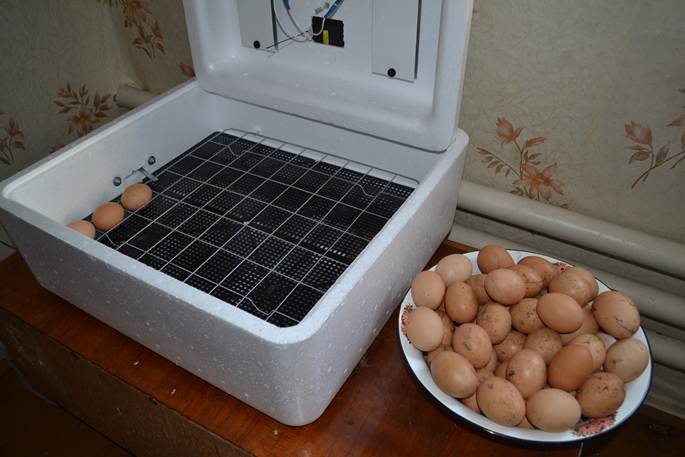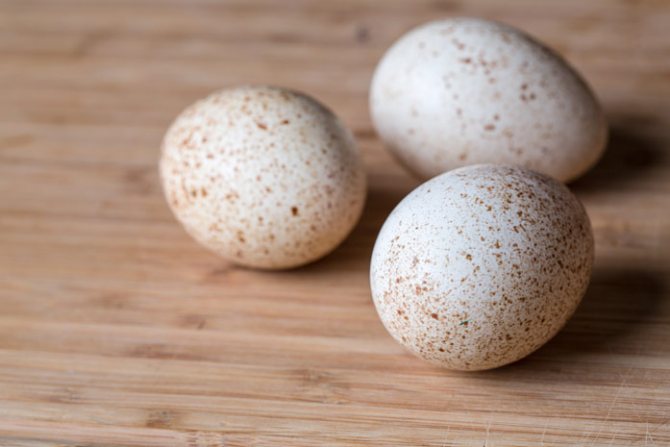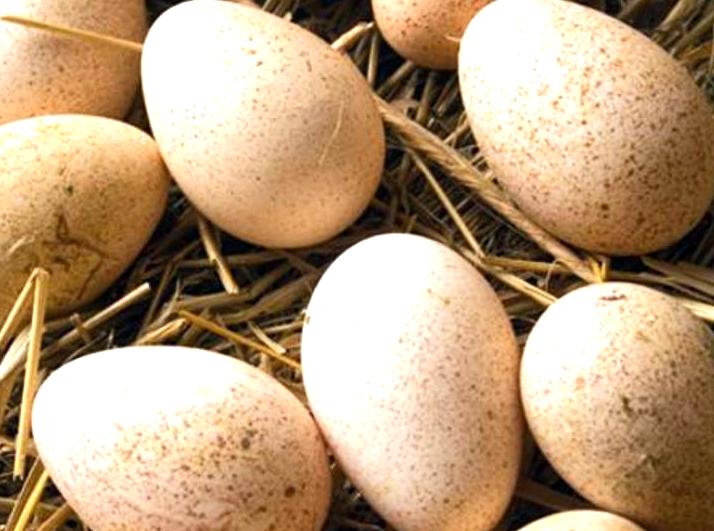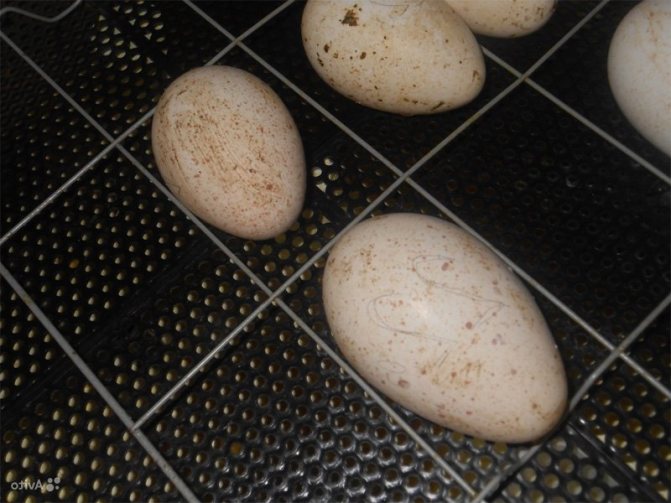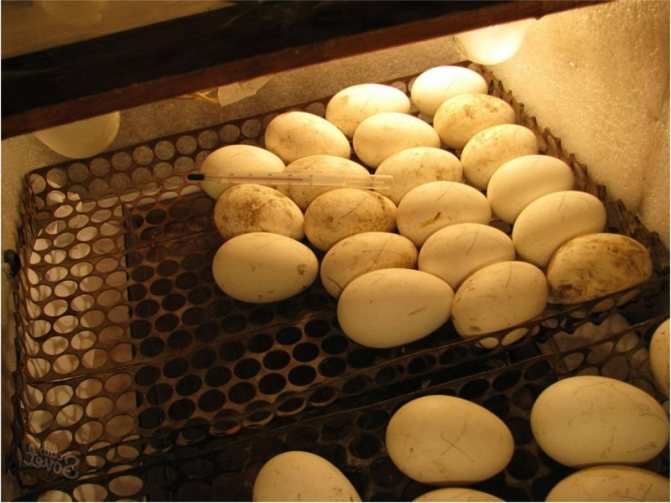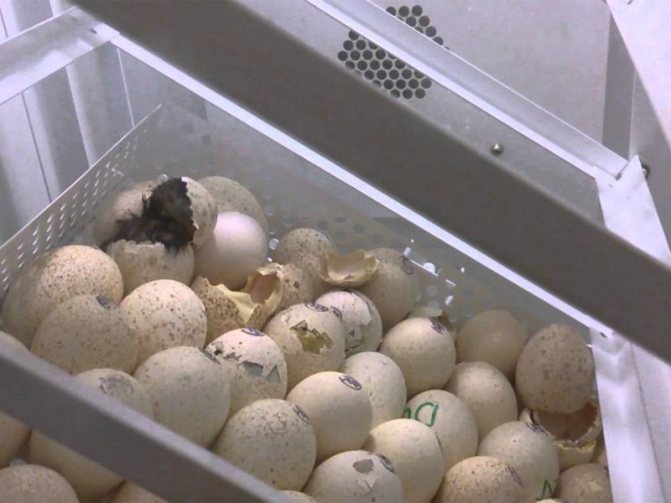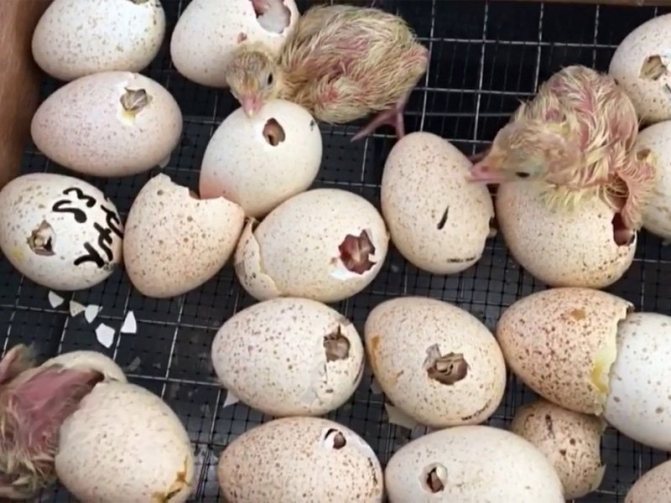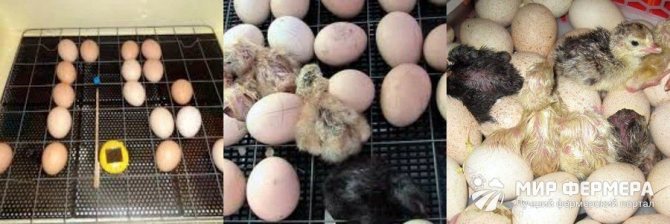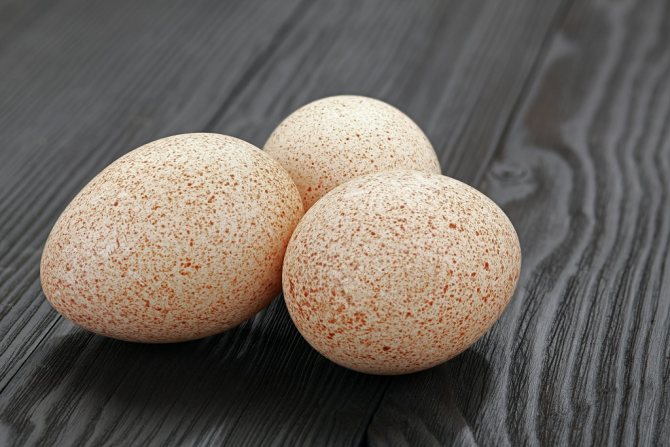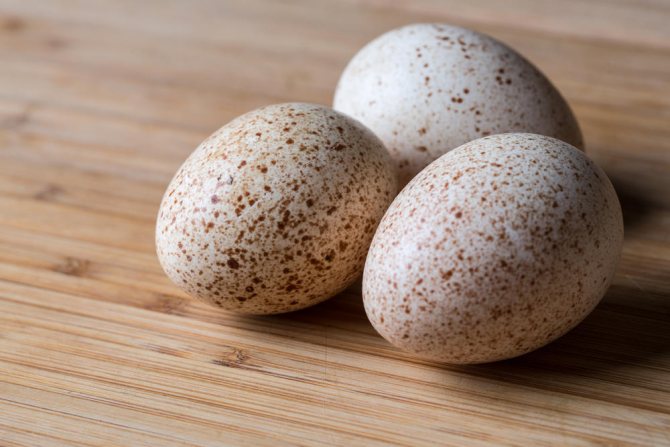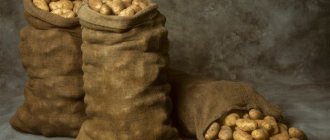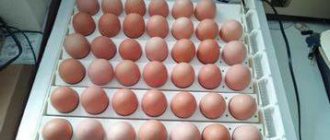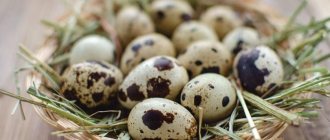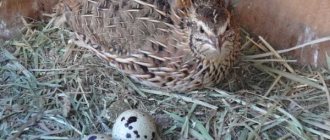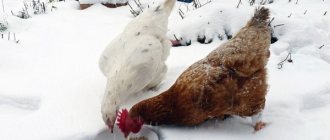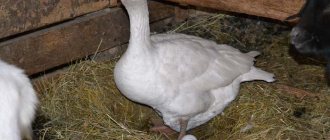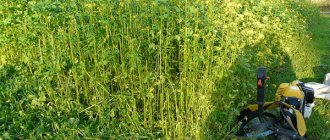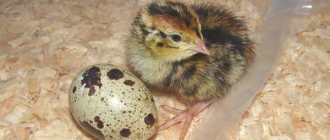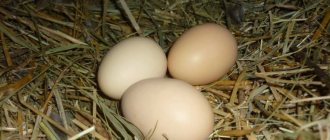Features of the incubation of turkey eggs: rules and regulations
The incubation process of turkey and chicken eggs follows the same principle, but has different regime parameters.
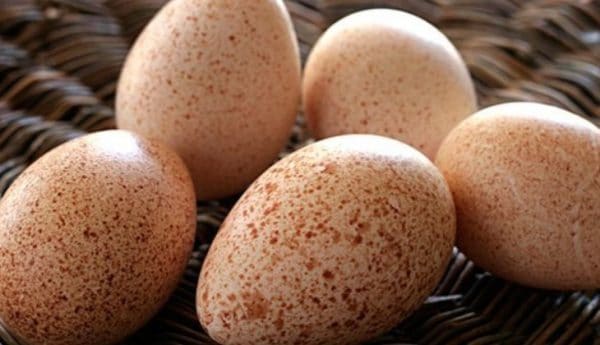
Hatching turkey eggs
Incubating turkey eggs inside an incubator is different:
- humidity level;
- air temperature;
- ventilation quality;
- the frequency of rotation of the incubation product;
- cooling and spraying frequency;
- incubation period.
If you observe all the regime indicators, then you can achieve the highest possible results for the withdrawal. Unlike chicken and goose eggs, turkey specimens must be turned over in time.
The rate of hatchability depends on the frequency of their overturn.
Birds whose eggs are used for breeding are kept under special conditions... Male and female turkeys are kept in separate poultry houses. To fertilize the eggs, the females are caged with the males for 6 hours.
The hen instinct of a turkey develops when there are 15 eggs in a clutch. Therefore, the collection of eggs is carried out before their number in the clutch reaches this figure. Only females that have reached 8 months of age can enter the hatching flock.
Choosing a breed of turkeys for incubation
To get the most out of your turkey breeding, it is important to select a breed with the optimum performance.
Experienced poultry farmers recommend opting for one of the following breeds:
- North Caucasian bronze. This is one of the most popular turkey breeds. Adult turkeys gain weight up to 15 kg, turkeys - up to 8 kg. A turkey lays up to 80 eggs per year.
- Bronze broad-breasted. This popular beef breed is similar to the North Caucasian turkeys. Weight of turkeys - 19 kg, turkeys - 12 kg. Egg production - 100-120 pieces per year.
- Station wagon. The breed is characterized by rapid weight gain. The weight of turkeys - 10 kg, turkeys - up to 18 kg. Egg production - 60-70 pieces per year.
- Moscow white. Highly productive breed, easily adaptable to different weather conditions. The weight of turkeys - 8 kg, turkeys - up to 16 kg. Egg production - up to 100 pieces per year.
For more information on turkey breeds suitable for home breeding, see the article here.
It is also important for successful incubation how healthy the laying hen is - genetically and physiologically, because the quality of the eggs selected for hatching depends on this. When choosing eggs for divorce, they are taken from layers that differ in the following parameters:
- wide chest;
- massive hips;
- straight and powerful legs;
- long and straight keel;
- healthy eyes - they should be rounded, with well-defined edges.
Selection of devices for breeding
If we compare the natural hatching of birds and hatching, then with the natural method, the number of birds is 2 times less.
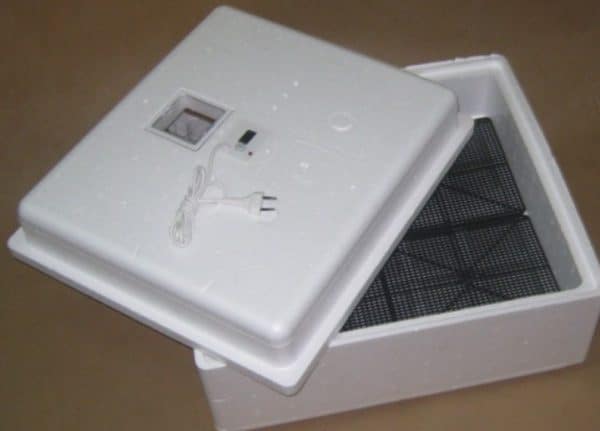

Household incubator
A quality incubator will ensure a large hatch rate of healthy chicks. Devices are produced:
- With top or bottom heating element. Bottom heaters retain heat better than top heaters. This is because some of the heat from the top heating element escapes through the ventilation holes.
- With different sizes of inner chamber. The devices with large chambers are used for the production of turkey poults on an industrial scale. The chamber accommodates a laying of eggs from 500 to 2 thousand pieces.Household appliances allow you to store from 30 to 150 pieces.
- With or without auto-rotate function. When using a device without an auto-rotate function, the masonry is turned over independently.
- Manual or automatic control. Unlike automated incubators, in which the required temperature regime is set once, manual control devices require constant monitoring. The temperature is checked 2-3 times a day and adjusted depending on the indications.
The most popular devices equipped with humidity and temperature sensors: "Laying hen", "Ideal hen", "Blitz". These devices have an auto-rotate function.
Preparation process
First of all, having decided to breed turkey poults through an incubator, they begin to select eggs. Experts advise choosing copies of the same size. The best eggs are taken from turkeys over 8 months of age. Do not leave them in the nest. As soon as there are more than ten eggs, the maternal instinct may wake up in the female, and she will begin to incubate them.
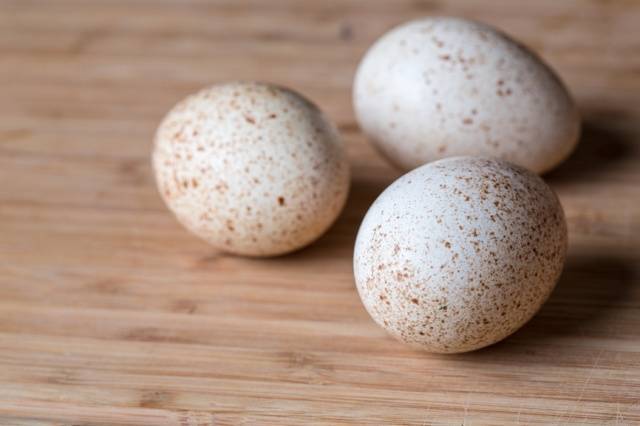

Before placing in the incubator, all specimens must be cleaned (but not washed) of dirt. This must be done carefully so as not to damage them. It is also worth paying attention to the growths and defects on the shell. It is better not to place such specimens in an incubator. If they have build-ups or are very thin shells, this indicates that there is a serious problem in the house. It is better to eliminate diseases on time, disinfect, and the birds are fed with chalk and sprat.
The conditions for the selection and storage of material for incubating turkeys are given in the table below.
+12 degrees Celsius
Should not exceed 80%
Storage placement
Blunt end up, after four days of storage they are turned over
Maximum storage time
No more than 10 days
Disinfection before incubation is an optional process, but recommended by most experts. To do this, you can use:
- hydrogen peroxide;
- glutex and other special solutions;
- potassium permanganate solution.
Specialized tools can be easily found on sale today. Incubation of turkeys with a large number of eggs should be carried out using professional means.
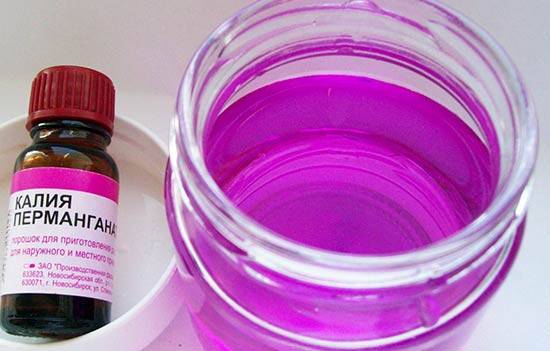

Determination of the quality of eggs
On large farms, hatching eggs are carefully checked. For this, the process of ovoscopy is used.
The rules for ovoscopy are as follows:
- in the light it should be visible that the protein has no extraneous inclusions and is absolutely transparent;
- the yolk should have clear contours and be located in the middle of the egg;
- the air chamber should always be located at the blunt end;
- when turning the egg, the yolk should move slowly.
If all points are met, such an egg can be considered ideal. From it you can get healthy offspring in an incubator.
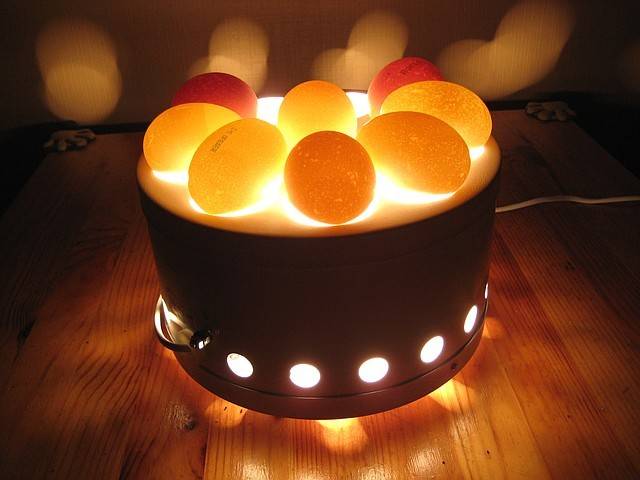

To study the process of ovoscopy in more detail, we recommend watching this video:
Breeding new offspring is a responsible process, incubation modes are of great importance here.
How to choose eggs for incubation
Only the carefully selected product is placed in the incubator. by external and internal qualities. The poultry farmer examines the inside of the product with an ovoscope.
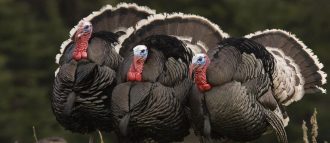

Be sure to read:
Turkeys: features of care, cultivation and breeding at home
Features of a high-quality copy when translucent:
- has one yolk with blurred borders;
- the yolk is in the center: if you turn the egg, it slowly flows;
- the protein looks transparent;
- an air chamber is visible at the blunt end of the egg.
Chicks are born weak if small and large types of eggs are used for incubation. The percentage of hatchability from such specimens is small.
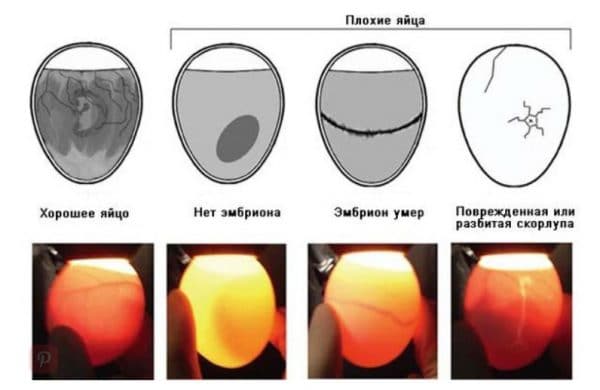

How to choose eggs for incubation
Medium sized eggs with a clean and smooth surface are laid in the device. Damaged specimens, rough and with outgrowths are discarded.
A defective specimen is considered to be round, excessively elongated and with bluish-green spots. A quality egg is white. There are light beige specimens with a brown tint.
The size and size of the eggs are chosen depending on the breed of birds:
- A wide-breasted white turkey produces about 120 eggs per year. The incubation product has a weight of 80 to 90 grams.
- The bronze North Caucasian bird weighs up to 15 kg. Egg production per year is 80 pieces. The weight of the incubation product is 100 g.
- Bronze broad-breasted - outwardly similar to the North Caucasian breed, yields up to 100 eggs per year. For incubation use a product weighing 85 g.
It will not work to breed birds if you choose low-quality incubation material.
Selection of eggs
Only fertilized eggs are required to hatch chicks. In addition, they must meet other requirements:
- you cannot use spherical eggs - they have an insufficient amount of protein, which is fraught with starvation of the embryo;
- too long and large are not suitable, since they often contain 2 yolks;
- the surface of the egg should be clean, smooth, without sagging and cracks;
- the shape, size and appearance of the egg must correspond to the standard parameters inherent in the breed. You should not choose the largest specimens, medium-sized ones are optimal.
Read about turkey eggs here.
Ovoscopy
To determine whether an egg is fertilized or not, external signs are not enough. To do this, use an ovoscope: any kind of device that generates a light strong enough to illuminate the egg through. You can find out about ovoscoping quail eggs at this link.
The test egg is applied to the opening of the device or placed on a lattice and translucent. The selection is carried out according to the results of the inspection:
- in specimens suitable for reproduction, the yolk is located in the center, along the vertical axis closer to the blunt end. When turned over, the yolk moves to the wall, and then returns to its place;
- when translucent, the air chamber should be clearly visible. The yolk is defined as a shadow with vague borders;
- if the yolk does not return to its place, it means that one of the grains holding the yolk in the center is torn off. Such a product is discarded;
- if the yolk is placed too close to the shell, and even more so in contact with it, the egg is also considered unsuitable;
- specimens are not used in which there is a rupture of the yolk membrane, and part of the yolk has mixed with the protein;
- eggs with bloody spots are also unsuitable, as this indicates damage to the capillaries.
The Ovoscope does not provide a 100% guarantee. At the first stage, knowingly defective material is screened out. On the second - 8 days after laying, the procedure is repeated in order to remove specimens that are not fertilized or with frozen embryos.
Egg storage before incubation
Regardless of the breed, eggs can be stored for no more than 10 days before laying. The more time elapses before incubation, the lower the hatchability. So, when stored for 5 days, the hatchability is 84%, when stored for 10 days - 73%. If 20 days have passed before laying, it will not be possible to get more than 50% of the chicks. And after 25 days, the eggs become unusable altogether.
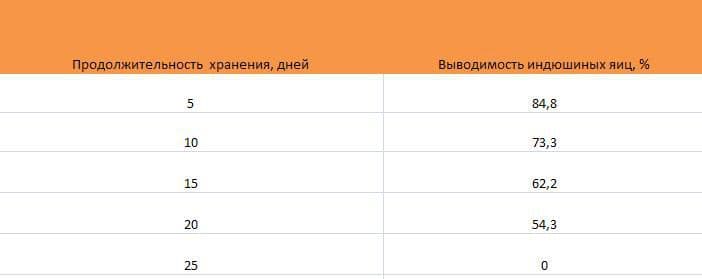

Table of storage times for eggs before incubation and hatchability.
Store them with the blunt end up. Turn over every 4 days. Under no circumstances should they be washed.
How to store and handle eggs before laying
The hatchability rate is directly related to the shelf life of the eggs. The withdrawal percentage decreases if the product has been stored for a long time. Poultry farmers are advised to give preference to specimens, which from the moment of demolition are not more than 10 days.
Hatchability percentage table depending on storage:
| Storage period, in days | Hatchability percentage,% |
| 5 | 85 |
| 10 | 73 |
| 15 | 62 |
| 20 | 54 |
| 25 |
The entire incubation product is stored in a dark, dry room with a humidity of up to 80% and a temperature of +12 ° C. Refrigeration is not permitted.
The entire product is stacked so that the sharp end is at the bottom. Eggs are turned over once every 4 days, this will help the future embryo to form correctly.
Before loading the incubator, it is disinfected with special agents. Eggs are also disinfected. This will protect the hatched chicks from infections.
Glutex, Virocid and Ecocid are used as disinfectants. These substances are sold at any veterinary pharmacy.
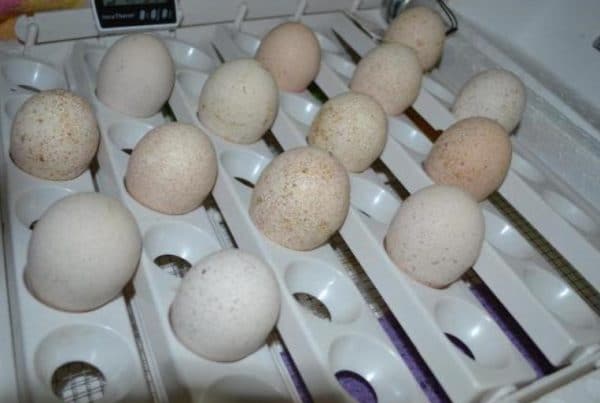

Setting eggs in the incubator
To prepare a solution with your own hands, use hydrogen peroxide and potassium permanganate diluted in warm water. The eggs are wiped with a soft cloth, after dipping it in the prepared substance.
Then they wait until the shell is dry. Eggs cannot be wiped with a dry towel. There is a protective shell on the shell that can be damaged.
Incubation work
Experienced poultry farmers say that the maximum hatchability of chicks can be achieved if certain conditions are met.
Incubator bookmark
You will have to check:
- the quality of the material for the bookmark;
- compliance with storage conditions;
- compliance with temperature and humidity levels.
Future turkeys will have to spend 28 days in the incubator. Pecking can last from 27 to 29 days.
Incubator bookmark
When planning to load the incubator, you should first bring eggs into the room. They should warm up to room temperature.
The eggs should warm up to room temperature.
Disinfection is one of the mandatory steps. Initially, all prepared specimens are cleaned of adhering dirt and debris, and then dipped in a disinfectant liquid. You can also soak a napkin or soft cloth in the solution and gently wipe each egg.
Attention! You do not need to wipe them: let them dry on their own. When wiping, there is a risk of damage to the protective shell.
Disinfection is carried out using:
- potassium permanganate, from which the pale pink solution is made;
- hydrogen peroxide;
- pharmacy products "Glutex", "Virotsid".
Potassium permanganate solution
All internal parts of the incubator are washed and disinfected separately.
After completion of all disinfecting work, start laying. The placement of the incubation raw materials will depend on the chosen incubator model. Possible vertical or horizontal loading.
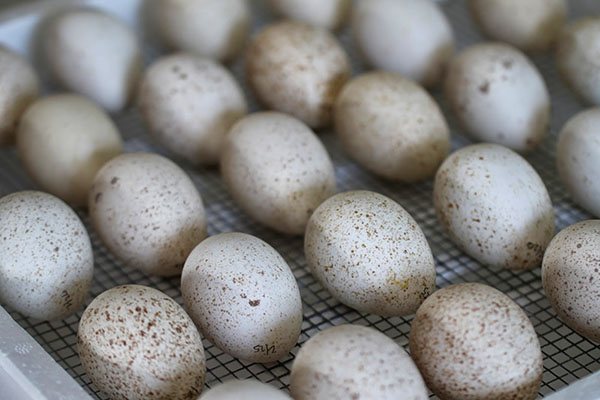

The procedure for placing eggs in the incubator
In most cases, models with vertical placement of eggs have an automatic flip function. They are installed in special trays so that the sharp edge is directed downward. They are not placed strictly vertically: the slope level is 45o.
Eggs are best placed at an angle of 45 degrees.
If placed horizontally, the farmer will have to turn them all over by hand. For control, experts recommend putting 2 marks on each egg: on one side they draw a cross or a strip, on the other - an oval.
The incubator is preheated. Experts recommend that you familiarize yourself with all the nuances of incubation in advance in order to fully control the process.
Rules for placing eggs in an incubator
Before loading the incubator, eggs must lie in the room for several hours and warm up. There are 2 loading methods: horizontal and vertical.
What is the difference:
- Horizontal. The incubation turkey egg is laid out on a net. With this arrangement, the product is turned over manually. In order not to confuse the sides, they make a mark on the top of the egg with a marker.
- Vertical. The device has an automatic flip function. Eggs are turned with the pointed end down and placed in trays. In this case, the angle of inclination is 45 °.
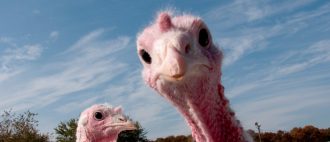

Be sure to read:
How to treat histomonosis in turkeys and chickens, the first signs of the disease and preventive measures
Timely turnover of the clutch affects incubation. The first turnover of eggs is carried out 12 hours after laying. Subsequent coups are done every 3 hours, 12 times a day.
The procedure lasts 24 days. The first 12 days, the masonry is moistened 2 times a day, spraying it with water. This will help keep the humidity at the correct level and prevent the hatching product from overheating.
Humidification is done when the device is ventilated. The procedure is increased up to 3 times a day, starting from the 13th day and ending on the 24th. Turning over and spraying is discontinued on the 25th day.
Important information
- hatching of young animals lasts about 10 hours;
- after 24 hours, turkey poults can be given food and water;
- chicks are given some time to dry out;
- incubation lasts 28 days;
- as soon as the young growth begins to hatch, it is recommended to look after them, the cracks should be in the upper part of the egg;
- humidity plays an important role, there must be water in the trays;
- chicks are not provided with assistance at the time of hatching, this can harm them;
- in case of violation of the egg coup regime, the young are born with pathologies of the limbs, such chicks are discarded;
- you need to take eggs only with clean hands, otherwise pathogenic bacteria can penetrate under the shell;
- It is recommended to keep poults and chickens separate, this practice helps to prevent possible infections.
If the vaccination of young animals is carried out immediately after the birth of individuals, then the turkeys and chickens will calmly get along together for some time. They need to be seated at the time of the transition to feed for adults (birds have different diets), or at a time when the turkeys become large enough for everyone to have enough space.
Temperature conditions inside the incubator
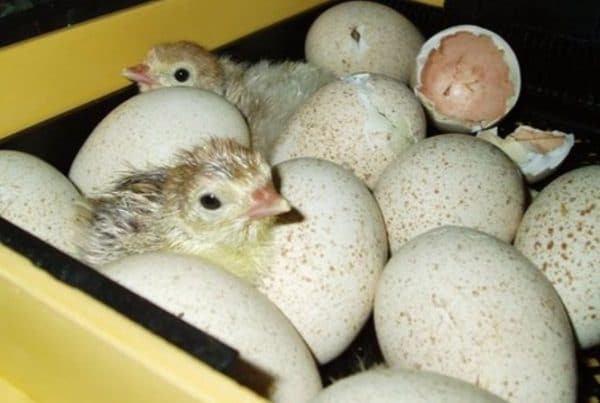

The humidity in the incubator for the first 3 days should be 65%
At the time of laying, the temperature inside the device must be +38 ° C. She is maintained at this level for 3 days. On the fourth day, the temperature is lowered to +37.6 ° C and held for 2 weeks.
The respiratory organs in the embryos close on the 15th day and the temperature of the eggs rises on their own. Therefore, the temperature is kept at +37.5 ° C.
Airing the device is done on the 10th day, 10 minutes in the morning and evening. From the 15th day, airing is increased up to 3 times a day for no more than 15 minutes. On the 25th day, the temperature is set at +37 ° C, and on the 27th day, turkeys appear.
Useful video on the topic
Like the author! 5
- Even more interesting:
- Breeding Indoors in an incubator
- Incubation of duck eggs
- Detailed process of incubating guinea fowl eggs
Discussion: there is 1 comment
- Peter:
02.02.2019 at 19:25I didn't succeed in raising turkey poults for the first time, because I made some mistakes. But now I don't do them and I am happy with the result.
Reply
Ventilation and humidity inside the device
The humidity in the incubator for the first 3 days should be 65%, then it is lowered to 45%. Secondary augmentation is performed on day 15. In order for the chicks to freely get out of the shell, it must not be allowed to dry out.
Therefore, the humidity is increased to 70% and kept at the same level as soon as the first bite appears before the hatching process.
Each incubator is equipped with ventilation holes that allow ventilation of the masonry during the entire incubation period. But a thin shell tends to absorb smell, but drafts should not be allowed.
The device is accompanied by instructions, which indicate the rules of use and the frequency of ventilation.
The ratio of humidity and temperature indicators is presented in the table:
| Days | Humidity,% | Temperature, % |
| 1-2 | 60-65 | 38-38,3 |
| 4-14 | 40-45 | 37,6-38,0 |
| 15-24 | 60-65 | 37,5-38,0 |
| 24-27 | 65-70 | 37,0 |
For a high percentage of turkey hatching, these indicators are the most optimal.
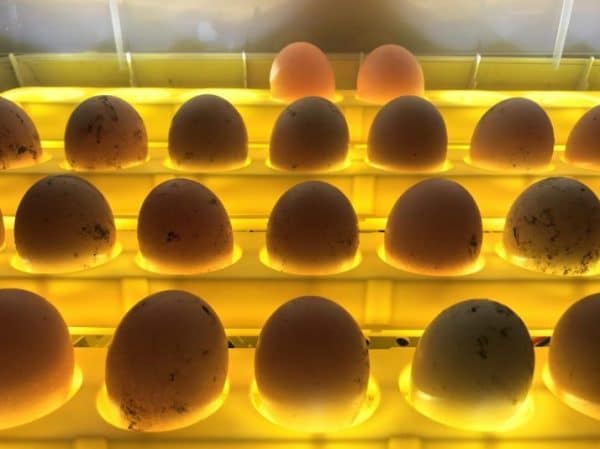

Each incubator is equipped with ventilation holes
When do turkeys hatch?
Hatching a turkey chick
The incubation period for turkey eggs lasts 27 days. The first eggshell bites are observed already on the 25th and 26th days. And by the end of the 27th day, the mass breeding of turkey poults in the incubator begins. It lasts several hours - on average, from 6 to 8.
Read also: Chicken louse and the fight against it: drugs for parasites, prevention
It is not recommended to frequently open the device and check how the process is going. This is fraught with hypothermia while still wet chicks. The turkey poults in the incubator should dry out completely, only then the removal is carried out.
If the hatching lasted longer than 8 hours, it is better to do the notch twice, but not more: after the bulk of the chicks have dried out, and a second time to pick up the remaining belated ones.
Incubation stages
Each stage of incubation is illuminated with an ovoscope. This allows you to remove in time specimens that have not fertilized or have stopped in development.
For the entire incubation period, the examination is done 3 times:
- On the 8th day, the first examination is carried out. The embryo is in the yolk and cannot be seen. But the circulatory system is clearly visible, since it has already been developed by this time. The area in the yolk where the living organism is located has a light shade. To see how the embryo moves, the egg is swayed slightly. The embryo died if inside the yolk, instead of a light spot, a dark one is visible.
- On the 13th day, repeated transillumination is carried out. You can already see the closed allantois from the sharp side of the product and the contours of the embryo. In a healthy embryo, the vascular network is also visible. If through the ovoscope you can see a dark unformed spot that dangles inside, then the embryo did not survive. The vascular network of dead embryos has no blood and is atrophied. Such specimens are removed from the incubator.
- By the 26th day, turkeys are preparing to be born. He completely takes up the egg, moves and protrudes his neck. If the movements of the embryo are not visible, then it is dead.
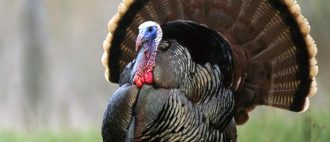

Be sure to read:
Turkeys sit down, fall to their feet: what is the reason, if paws of turkeys disperse, how to treat?
When do turkeys hatch?
The entire incubation period lasts for 27 days. The chick hatches on the 25-27th day after the incubation product is inserted into the device.
What to do when hatching turkey poults:
- Do not open the lid and observe the pecking process. The chicks that appear are wet, and cold air trapped inside the device can chill them.
- The chicks are taken out of the device after complete drying.
- There should be no drafts during the period of biting, but there should be plenty of fresh air.
- Collective hatching occurs on the 27th day. This process takes about 10 hours. During this period, the air temperature is set to +37 ° C. They wait for the poults to dry, then take them out.
- For the remaining eggs, the temperature is raised again. The rest of the chicks should appear within 24 hours. It can take several minutes or hours for them to hatch.
The young are kept in warm conditions for 9 weeks. Food is selected fortified with vitamins. The food should also contain boiled eggs, low fat cottage cheese and corn grits.
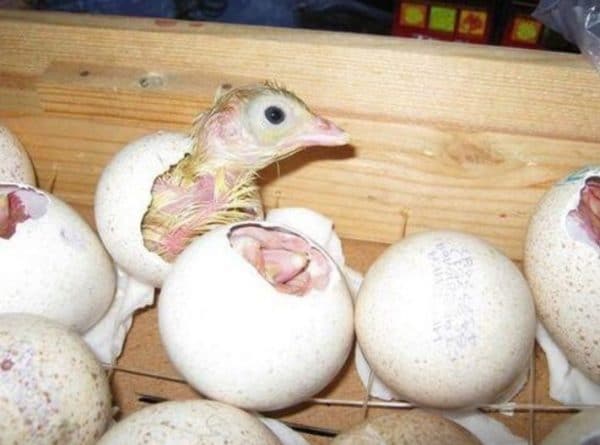

No need to help chicks to hatch
Hatching process and subsequent care of turkeys
When hatching begins, fresh air must be supplied to the incubator. But drafts are excluded - chicks can catch a cold and die. While the process lasts, you should not look into the incubator so that wet turkeys do not get overcooled - because of the cold air entering the incubator when the lid is opened.
Most of the turkey poults hatch at the same time. The interval between the first and the last hatched is a day or more. During mass hatching, the temperature is lowered to 37 ° C.
The first two weeks are the most difficult. It is important to organize ideal conditions for turkeys:
- The hatched chicks are placed in a box with a heating pad. A cloth is laid on the bottom. Optimum temperature 35 ° C.
- From 6 to 10 days, the temperature is lowered to 30 ° C.
- By day 30, the optimum temperature is 20 ° C
Aviary keeping of turkey poults is allowed on the 10th day.
The shell remaining after hatching is boiled for 20 minutes and fed to the turkey poults. These chicks need more care than other poultry. For 9 weeks they are kept warm, fed with easily digestible fortified feed with a high protein content.
On the first day, turkey poults are fed only boiled eggs mixed with wheat or corn flour. When the chicks are one week old, the egg is removed from the diet.
In the first two weeks, turkeys are fed:
- onion feathers;
- grated carrots;
- millet;
- low-fat cottage cheese;
- corn grits;
- nettle and dandelion.
From the 15th day, turkey poults are given boiled and finely chopped offal.
Trays with chalk, fine gravel, shells are placed next to the feeders. First, the chicks are fed at 3 hour intervals. Over time, the number of feedings will decrease.
If the chicks do not have a brooding mother, they have to be taught to eat - they tap their fingers on a bowl of food. By dipping the beaks of turkey poults into the water, they are taught to drink.
In the first few hours, poultry farmers give the turkey poults glucose and vitamin C, diluted in water. Potassium permanganate is added to drinking water for disinfection.
The most common mistakes
Sometimes when breeding young, a number of mistakes are made that affect the percentage of hatchability. This is underheating or overheating of the masonry, high or low humidity, as well as the lack of a timely coup.
What's happening:
- With poor heating, the surviving embryos hatch 3 days later than the due date. Their down is uneven and dirty. Chicks move poorly, their legs are weak. Edema is visible in the neck and on the head.
- The embryo dies or is born with deformities if the masonry is overheated. Withdrawal occurs ahead of schedule.
- Due to the high humidity, turkey poults hatch later. They are born sticky and dirty. It is difficult for them to get out of the shell, and many do not survive.
- At low humidity, the weight of the eggs decreases. Because of this, early excretion occurs. The shell hardens a lot, and it is difficult for the chicks to get out from the inside. They are born dry.
- With rare clutch overturns, the embryos adhere to the shell and die. Surviving fetuses are born with deformities.
Incorrect setting of regimes is characteristic of novice farmers.
Incubator requirements
Not every farmer has the opportunity to hatch turkey poults under a hen, besides, it has long been noticed that with artificial breeding, a larger number of chicks are born.
Incubators are of two types:
- heating is in the upper part;
- heating occurs from below.
In nature, birds sit on eggs, which means that heat comes from above, due to which the embryos are located in the upper part of the egg. According to this feature, it is logical that the heater will be located at the top. There is also a drawback here: obeying the law of physics, heat rises upward, which means that the air so necessary for warm eggs will come out through the ventilation.
With heaters located at the bottom, the heat will be used more economically.
Whichever system is chosen, both of them are not perfect, the heating of the incubation material is uneven, which is not very effective.
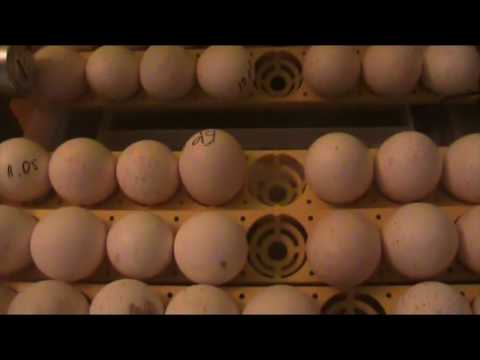

Some breeders are improving their incubators to be as close to natural conditions as possible. For this, the top and bottom are sheathed with metal with holes, and the heating system is located in the chamber. The height is calculated based on the dimensions of the heater.
Ovoscopy
The procedure means translucent material for hatching turkey poults with light to determine its quality. Optimally, the yolk should be centered and not clear-cut. An important point is that the air chamber should be in a blunt edge.When turning the object during ovoscopy, the yolk inside should not move too quickly.
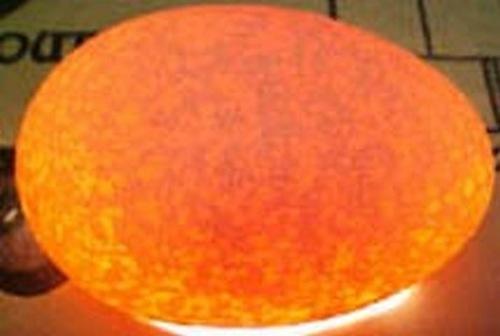

The protein is normally transparent. If specimens with two yolks are found during the study, they must be set aside. Ovoscopy provides an excellent opportunity to assess the internal state of the incubation material so that you get healthy and viable chicks in the future.
Chick Mode
The bite is usually clearly visible on the surface after 25 - 26 days. Before this important moment, it is advised to conduct an examination with an ovoscope for the last time. What is ideally visible in the light? Under the condition of normal development, the egg inside will be dark, up to the location of the air chamber. Its border should be in motion and be somewhat blurred. The rotation of the copies must be stopped from the moment of pecking - on the 25th day.
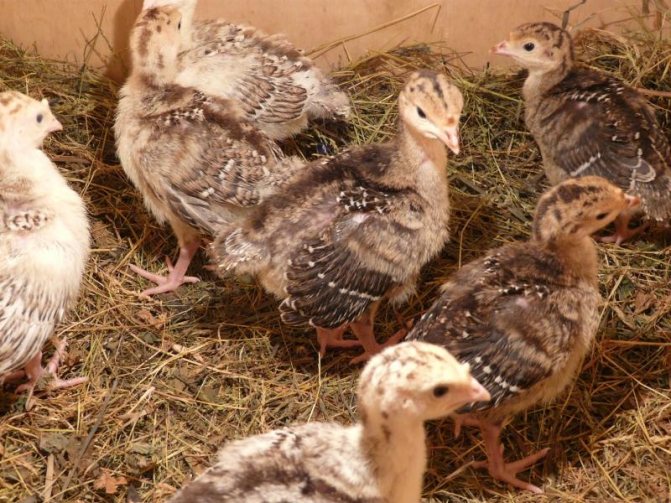

During this period, the hatching of the young is expected. Each egg should be as hot as possible, for which the temperature increases. It is 37 degrees, the degree of humidity is increased to 65 - 70%. Chicks will need a lot of oxygen. This can be achieved by providing them with adequate ventilation. The appearance of babies at home should be expected by the end of the 27th day.
For a massive and even appearance of young animals, the temperature on this day should be increased to 37 degrees. After the end of the process, the shells are collected, boiled for about 20 minutes and fed to the kids.

